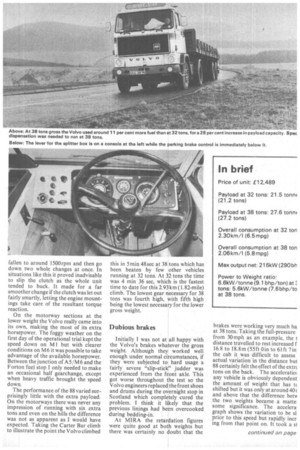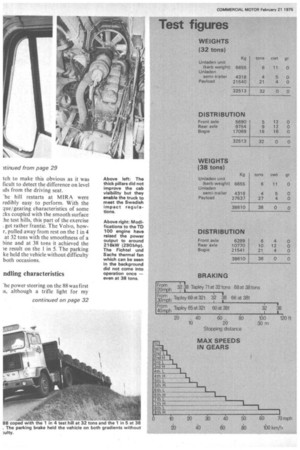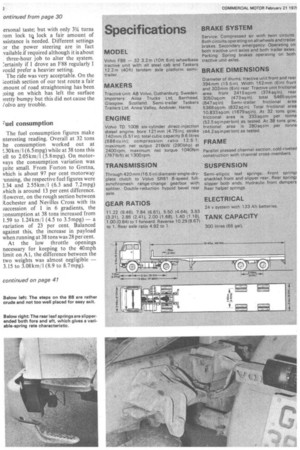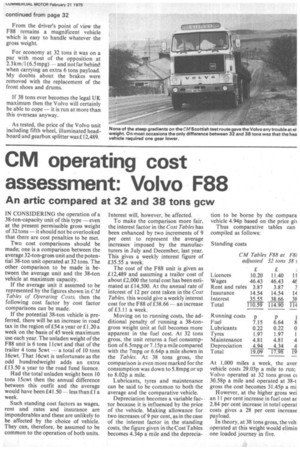Volvo F88/Taskers 32 and 38 ton gcw artic
Page 30

Page 31

Page 32

Page 34

Page 43

If you've noticed an error in this article please click here to report it so we can fix it.
By Graham Montgomerie Pictures by Dick Ross
SINCE its introduction to the UK market in 1967 the F88 Volvo has won a reputation as one of the pacesetters in the heavy end of the market. Recently the Gothenburg company announced several engine modifications which brought the power output up to 2 I 6kW (290 bhp). Such a figure is certainly useful for 32-ton-gross operation and still more than adequate for 38-ton operation if the SM MT recommendations to run at the higher limit are accepted.
CM has just completed an operational trial of a new F88 at both 32 and 38 tons gcw. The truck and trailer were the same in both cases and were run over our full test route to Scotland and back during the same week.
The overall fuel consumption was found to vary from 2.30 to 2.05km/ 1 (6,5 to 5.8 mpg) between 32 and 38 tons. This was an increase in fuel consumption of about II per cent for an increase in payload capacity of 28 per cent.
The total journey time was hardly affected. The 38-ton unit met less heavy traffic than the lower weight combination, which tended to counteract the slighter lower vehicle performance. The total journey time of 17 hours at 32 tons compares with the 17 hours 34 minutes at 38 tons.
The cab
Although it has been around for many years now compared with some of the opposition, the Volvo cab can still be classed with the best of them. The control layout is good, the instrument arrangement simple and eminently readable. Cab visibility is only reasonable, however, the front pillars being on the thick side; but on the other hand the cab does have to meet the very stringent Swedish impact regulations and these cannot be met with wafer thin pillars. You can't have it both ways.
In some respects the big Volvo cab looks its age. The flat split screen does not give the truck a particularly stylish appearance but the glass will certainly be cheaper to replace than in a curved screen. Considering the angular cab shape and this flat screen I was surprised at the very low wind noise, which helped to combat driver fatigue. The provision of a roof hatch for ventilation was certainly appreciated, as opening the quarter lights just about doubled the ii cab noise.
The cab's normal quietness was part due to the absence of fan noise. Fichtel und Sachs thermal fan is fittc but at no time on the complete Scotti: test route at either weight did the fi come into operation!
At first glance the clutch pedal loo: set at an unreasonable angle but in fa it is extremely comfortable in use an rate the gearchange arrangement about the best currently available. r basic eight-speed range-change bc would probably be adequate on its ov for 32 if not 38 ton operation but t splitter option meant that exactly t right gear was always available for a. situation. You may not need all t gears all the time but it is comforting know they are available.
On the road
At 32 tons on the road I used whc gear changes on the flat, and the ext half changes on long consiste gradients such as Keele on M6. ( really nasty slopes like Riding Mill a Ridsdale the recommended techniq was to wait until the engine speed h fallen to around 1500rpm and then go down two whole changes at once. In situations like this it proved inadvisable to slip the clutch as the whole unit tended to buck. It made for a far smoother change if the clutch was let out fairly smartly, letting the engine mountings take care of the resultant torque reaction.
On the motorway sections at the lower weight the Volvo really came into its own, making the most of its extra horsepower. The foggy weather on the first day of the operational trial kept the speed down on M I but with clearer conditions on M6 it was possible to take advantage of the available horsepower. Between the junction of A5 /M 6 and the Forton fuel stop I only needed to make an occasional half gearchange, except when heavy traffic brought the speed down.
The performance of the 88 varied surprisingly little with the extra payload. On the motorways there was never any impression of running with six extra tons and even on the hills the difference was not as apparent as I would have expected. Taking the Carter Bar climb to illustrate the point the Volvo climbed this in 5min 48sec at 38 tons which has been beaten by few other vehicles running at 32 tons. At 32 tons the time was 4 min 36 sec, which is the fastest time to date for this 2.93km (1.82-mile) climb. The lowest gear necessary for 38 tons was fourth high, with fifth high being the lowest necessary for the lower gross weight.
Dubious brakes
Initially I was not at all happy with the Volvo's brakes whatever the gross weight. Although they worked well enough under normal circumstances, if they were subjected to hard usage a fairly severe "slip-stick" judder was experienced from the front axle. This got worse throughout the test so the Volvo engineers replaced the front shoes and drums during the overnight stop in Scotland which completely cured the problem. I think it likely that the previous linings had been overcooked during bedding-in.
At MIRA the retardation figures were quite good at both weights but there was certainly no doubt that the brakes were working very much ha at 38 tons. Taking the full-pressure from 30 mph as an example, the distance travelled to rest increased f 16.8 to 18.8m (55ft Oin to 61ft 7in the cab it was difficult to assess actual variation in the distance but 88 certainly felt the effect of the extrz tons on the back. The acceleratioi any vehicle is obviously dependent the amount of weight that has tc shifted but it was only at around 401 and above that the difference betm the two weights became a matte some significance. The accelera. graph shows the variation to be sl prior to this speed but rapidly incr ing from that point on. It took a Si tch to make this obvious as it was ficult to detect the difference on level ids from the driving seat.
-he hill restarts at MIRA were redibly easy to perform. With the que/gearing characteristics of some .zks coupled with the smooth surface he test hills, this part of the exercise get rather frantic. The Volvo, howr, pulled away from rest on the 1 in 4 at 32 tons with the smoothness of a sine and at 38 tons it achieved the le result on the 1 in 5. The parking ke held the vehicle without difficulty both occasions.
lulling characteristics 'he power steering on the 88 was first is, although a trifle light for my ersonal taste; but with only 33/4 turns rom lock tq lock a fair amount of ssistance is needed. Different settings ar the power steering are in fact vailable if required although it is about three-hour job to alter the system. :ertainly if I drove an F88 regularly I vould prefer a heavier setting.
The ride was very acceptable. On the ■ cottish section of our test route a fair ,mount of road straightening has been ;oing on which has left the surface )retty bumpy but this did not cause the Jolvo any trouble.
;'uel consumption The fuel consumption figures make nteresting reading. Overall at 32 tons he consumption worked out at !.30 km/1 (6.5mpg) while at 38 tons this ell to 2.05km/1 (5.8mpg). On motorvays the consumption variation was luite small. From Forton to Gretna, vhich is about 97 per cent motorway ginning, the respective fuel figures were Z.34 and 2.55km/1 (6.3 and 7.2mpg) Nhich is around 13 per cent difference.
owever, on the rough section between kochester and Nevilles Cross with its 3uccession of 1 in 6 gradients, the .consumption at 38 tons increased from 1.59 to 1.24km/1 (4.5 to 3.5mpg) a variation of 23 per cent. Balanced against this, the increase in payload when running at 38 tons was 28 per cent.
At the low throttle openings necessary for keeping to the 40mph limit on Al, the difference between the two weights was almost negligible 3.15 to 3.08km/1 (8.9 to 8.7 mpg). From the driver's point of view the F88 remains a magnificent vehicle which is easy to handle whatever the gross weight.
For economy at 32 tons it was on a par with most of the opposition at 2.3 km/ 1 (6.5 mpg) and not far behind when carrying an extra 6 tons payload. My doubts about the brakes were removed with the replacement of the front shoes and drums.
If 38 tons ever becomes the legal UK maximum then the Volvo will certainly be able to cope it is run at more than this overseas anyway.
As tested, the price of the Volvo unit including fifth wheel, illuminated headboard and gearbox splitter was £12,489.












































































































